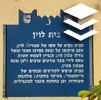The sign shape is square but its head is designed according to the silhouette of the old building of the Gymnasia Herzliya, which serves as a logo of the Council for the Preservation of Heritage Sites in Israel
The dairy building was photographed on the same day (you can see on the left the system of water pipes which, as stated on the sign, is the current use of the building)
 Click for a larger image
Click for a larger image Above the sign are other signs, which say:
The first operator of the dairy was
Kurt Shimon Alt
The dairy house was built in 1950
The dairy operator was
The late Shimon Artzi (Leon)
The building was used as a refrigerator, inside was a cold water cistern, where the milk that the dairymen brought was put.
The urns were waiting to be picked up by Tene.
Most of the milk came from the late Mali Menashe from Moshav Batzra.
Some of the milk is sold to the villagers and Yad-Harutzim villagers.
Bnei Zion had twelve cowsheds, a total of about 50 cows.
In the early 1960s, the then Minister of Agriculture, Moshe Dayan, passed a law for the planning of the dairy farm: the cowsheds will be moved to the northern and southern communities of the country, and in the kibbutzim and central communities, poultry will be raised for laying.
The dairy closed in 1964.
 Click for a larger image Translation of the text on the sign
Click for a larger image Translation of the text on the sign:
Symbol of the Council for the Preservation of Israeli Heritage Sites
Emblem of the Hof Hasharon Regional Council
The emblem of the Ministry of Culture and Sport
Symbols of Moshav Bnei Zion
The dairy In 1950 the dairy was built and a dozen dairymen brought their milk jugs to it. The urns were placed in a cistern, into which an ice block was thrown for cooling. The urns remained in the pit until a truck came and collected them.
On summer nights, a sheet was stretched on the wall of the dairy and films with a translation on the side were projected on it. The translation was done by a volunteer on duty.
In 1960 the dairy closed, and from then until the late 1970s the building served as the village’s spare parts warehouse.
From the end of the 1970s until today, the building has a drinking water system of the village.

 Click for a larger image
Click for a larger image  Click for a larger image
Click for a larger image  Click for all signs belonging to Heritage Sites in Israel
Click for all signs belonging to Heritage Sites in Israel
 1.55 Km |
1.55 Km |  1.56 Km |
1.56 Km |  1.57 Km |
1.57 Km |  3.41 Km |
3.41 Km |  4.81 Km
4.81 Km